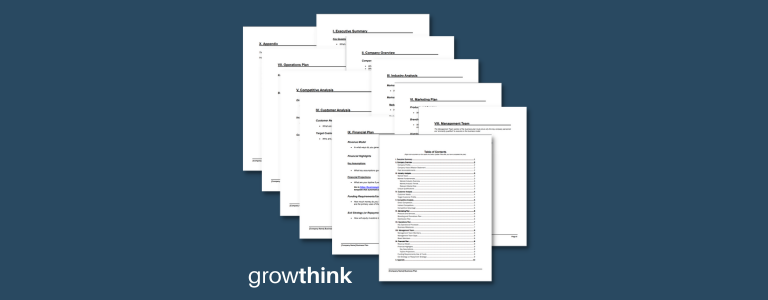Best Business Plan Template for Startups and Small Businesses
Growthink’s business plan template is the result of 25+ years of research into the business plans that help entrepreneurs and small business owners attract potential investors, raise investment capital, and build successful companies.
Using our business plan template, you will be able to write a proper business plan for your new or growing business. It will also help you lay out your business goals and your strategies for reaching them.
Importantly, our simple business plan template allows you to create a winning business plan much faster than starting from scratch. Our template features:
- Easy-to-follow instructions for completing each business plan section
- Questions to help you think through each component
- Automated financials to easily create your 5-year financial projections
What Does This Business Plan Template Include
This template includes the 10 key sections of a business plan, each with detailed guidance and examples to quickly and easily complete your own business plan.
1. Executive Summary
The Executive Summary provides a high level synopsis of your business plan, including your company’s business concept, mission statement, company description and an overview of your product and service offerings. The Executive Summary is the most important part of your business plan because if it doesn’t excite the reader, they won’t continue reading your plan, and they certainly won’t invest in your company.
2. Company Overview
This Company Overview section provides an overview of your business and lets readers know its history. Start this section with a concise explanation of your business and the products and services it offers.
3. Industry Analysis
The Industry Analysis section describes the market in which your company will be competing, including market research, data on target market segments, and industry trends.
4. Customer Analysis
The Customer Analysis provides insights about your key customer segments and their needs. This helps you create products, services and marketing strategies that best resonate with your customers.
5. Competitive Analysis
The Competitive Analysis identifies your direct and indirect competitors, assess their strengths and weaknesses, and show your company’s competitive advantages.
6. Marketing Plan
The Marketing Plan must detail your key products and services, your pricing strategy, your promotions plan and your distribution channels.
7. Operations Plan
The Operations Plan details the key day-to-day processes that your company performs to serve customers and the key milestones your company expects to accomplish as you grow.
8. Management Team
The Management Team section demonstrates that your company has the required management team and staff to be successful. Include short biographies of key personnel along with their qualifications and experience.
9. Financial Plan
The Financial Plan includes your 5-year projected business financials including your pro forma income statement, balance sheet, and cash flow statements. These financial statements should clearly illustrate your company’s revenue streams, sales volume and profitability over the next five years.
10. Appendix
The Appendix supports your overall business plan and should include your full financial projections along with any supporting documents that make your plan more compelling.
Finish your business plan today!
Download Growthink’s Ultimate Business Plan Template (including a full, customizable financial model) to your computer and finish your plan today.

Growthink’s Free Business Plan Template
Below is our free business plan template to help you get started on your plan. You can edit each business plan template to fit your needs and each one is printable.
Free Simple Business Plan Template
A simple, free startup business plan template in Word or PDF that can be used for any type of business.
Additional Business Plan Template Resources
Below are some of the best business plan template resources to help you quickly and easily complete your own business plan.

Growthink's Business Plan Template
Download Growthink’s Ultimate Business Plan Template and complete a solid business plan and your financial statements in hours.

Business Plan Examples
We have over 300 business plan examples for startups to help you to develop a professional business plan for your own business.
Writing a Business Plan and Business Plan Template FAQs
How Can I Access Growthink's Ultimate Business Plan Template?
Why You Need a Business Plan Template
Using a business plan template will significantly cut down on the time it takes to complete your plan. Specifically, our template, which:
- Starts you off with content already on the page. It’s hard to start any document from a blank page and having your key sections already listed is helpful.
- Lays out the key questions you must answer in each section, so you have guidance on what information to include and where.
- Helps you understand the questions you must focus on, and what’s not important, so you do a better job of conveying the key information readers need to know.
How Can I Write a Simple Business Plan?
Whether you are starting a new business or growing your existing business, you need a business plan. A business plan template will help you get started writing your plan and will provide you with a road map to long-term success and business growth. It should include the 10 key components of all business plans:
- Describe your business, mission and long-term goals in the executive summary.
- Explain the structure of your business, the physical location, and other basic business information in the company overview.
- Research your industry to explain current trends and influential factors for your business through a complete industry analysis.
- Identify the demographics and purchasing habits of your ideal customer in a detailed customer analysis.
- Better understand what your business is up against with a competitive analysis to identify their strengths and weaknesses.
- Develop a marketing plan that will help you reach your ideal customers, drive traffic to your website, and increase conversions.
- Create an operations plan that describes your day-to-day processes and procedures that make your business successful.
- Describe the management team that will be responsible for the success of your business.
- Create a comprehensive financial plan with realistic projections of where your business will be in the next 3-5 years.
- Attach supporting documents, financial statements, etc. in the appendix.
Learn the step-by-step writing process for how to write a business plan and get a startup business plan template.
If you need help writing your plan, Growthink’s expert business plan consultants can help. We have helped develop winning business plans for countless happy customers.
How Can I Get a Printable Business Plan Template?
If you’re looking for a printable business plan template, there are a few different options available to you:
- One option is to download a free business plan template.
- Another option is to purchase a template. These are often considered the best business plan templates because they are of higher quality and include a range of features that can help you to create professional-looking business plans and financial model including the income statement, balance sheet, and cash flow statements.
Ultimately, the best option for you will depend on your needs and budget. If you’re looking for high-quality, printable business plan templates that are easy to edit, then a purchasing a business plan template is the best option. If you’re on a tight budget or you don’t need a lot of features, then a free, simple business plan template may be a better choice. Whichever option you choose, make sure to take the time to customize the template to fit your specific business.
Is a Business Plan Required For Funding?
Yes, a written business plan is nearly always required when seeking financing. You need a business plan whether you are a small business, a startup, an existing business looking to grow or a seasoned business owner. Business plans fall into three common categories: business plans for funding, those used for strategy, and business plans for both fundraising and strategy.
Regardless of their business model, whether created from scratch or created using business plan examples for startups, many business owners use their business plans to raise bank loans to grow. The funding request allows them to acquire additional business resources and improve their financial health. New business owners often seek bank loans and SBA Loans as well as funding from angel investors and/or friends and family.
Importantly, regardless of the source of funding you desire, a good business plan will stand out to a potential investor by showing compelling reasons why you will achieve financial success. A successful business plan must clearly highlight the business opportunity and want investors to buy in. Investors will recognize a well researched business plan. A winning business plan will help you achieve long-term success, business growth and secure funding.
Finish your business plan today!
Download Growthink’s Ultimate Business Plan Template (including a full, customizable financial model) to your computer and finish your plan today.






